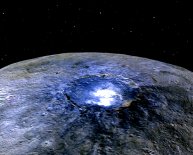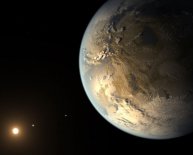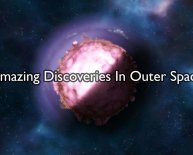
Newest space discoveries
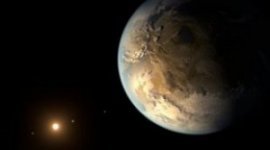 This artist's concept shows the newfound alien planet Alpha Centauri Bb, found in a three-star system just 4.3 light-years from Earth.
This artist's concept shows the newfound alien planet Alpha Centauri Bb, found in a three-star system just 4.3 light-years from Earth.
Astronomical discoveries in 2012 have reshaped what we know about the universe and pushed some instruments to the very limits of their observing power.
Scientists discovered a galaxy that harbors an enormous central black hole 17 billion times more massive than the sun. Another research group spotted a scorching-hot rocky planet in the closest star system to our own. Meanwhile, the records for most massive galaxy cluster and most distant galaxy were shattered.
Here's a brief rundown of some of the year's most extreme and exciting cosmic finds.
Most monstrous black hole
Observers probably don't want to get too close to NGC 1277 or its supermassive black hole, which takes up a large portion of the galaxy itself. The central black hole is 17 billion times more massive than the sun and makes up 14 percent of its host galaxy's mass, compared to the usual 0.1 percent.
Researchers were so flummoxed by the black hole's size that they took an extra year to double-check their calculations before publishing their results.
Closest exoplanet to Earth
 In a surprise discovery, astronomers found a planet that is about the same size as Earthin the star system next door. The rocky planet was found in Alpha Centauri, a three-star system just 4.3 light years from us. [Alpha Centauri Planet and Stars Explained (Infographic)]
In a surprise discovery, astronomers found a planet that is about the same size as Earthin the star system next door. The rocky planet was found in Alpha Centauri, a three-star system just 4.3 light years from us. [Alpha Centauri Planet and Stars Explained (Infographic)]
Life is very unlikely on this world. Its rocky surface may be molten, since the planet orbits just 3.6 million miles (6 million kilometers) from its sun-like star. (Earth, for comparison, circles 93 million miles, or 150 million km, from the sun).
Alpha Centauri Bb, as the planet is known, was discovered through tracking gravitational wobbles around its planet star. The wobbles in this case are very subtle, making the star move back and forth at no more than 1.1 mph (1.8 kph). The research team stated it "pushed our technique to the limit, " and some astronomers are skeptical that the planet even exists.
And just this month, a different research team detected five potential planets orbiting the star Tau Ceti, which lies only 11.9 light-years from Earth. One of the newly spotted candidate worlds may be capable of supporting life as we know it, scientists say.
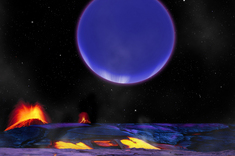 Artist's impression of five possible planets orbiting the star Tau Ceti, which is just 11.9 light-years from Earth.
Artist's impression of five possible planets orbiting the star Tau Ceti, which is just 11.9 light-years from Earth.
Smallest alien worlds
Astronomers using NASA's Kepler Space Telescope discovered three tiny planets 120 light-years away from Earth. Circling the star KOI-961, the smallest of the three planets is about the size of Mars, and all are smaller than Earth. Even the star itself is tiny — just 70 percent larger than Jupiter.
"This is the most compact system of planets, " said John Johnson, of the California Institute of Technology in Pasadena. "It's like you have a shrink raygun and set it to seven times smaller and zapped a planetary system."
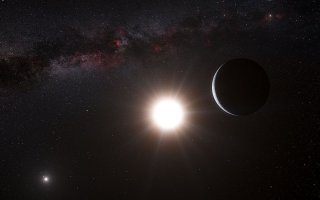 Smallest solar system
Smallest solar system
KOI-500 has five planets so crowded together that their gravity jostles each other profoundly during their orbits. Their "years" are only 1, 3, 4.6, 7.1 and 9.5 days long. Furthermore, the planets are tiny: just 1.3 to 2.6 times the size of Earth.
All of this action takes place in an area 150 times smaller than Earth's orbit, astronomers said.
"At this rate, you could easily pack in 10 more planets, and they would still all fit comfortably inside the Earth's orbit, " Darin Ragozzine, a planetary scientist at the University of Florida at Gainesville, said in a statement.
Astronomers have confirmed more than 800 planets beyond our own solar system, and the discoveries keep rolling in. How much do you know about these exotic worlds?
0 of 10 questions complete
Alien Planet Quiz: Are You an Exoplanet Expert?
Astronomers have confirmed more than 800 planets beyond our own solar system, and the discoveries keep rolling in. How much do you know about these exotic worlds?
0 of questions complete
Most distant galaxy
Much like the 100-meter dash world record, the record for farthest known galaxy often changes. The newest potential record-holderis UDFj-39546284, which had taken shape when the universe was only 380 million years old. Its extreme age was discovered in 2012 using new observations from NASA's Hubble Space Telescope.
The galaxy is part of a group of seven that astronomers examined, forming perhaps the first reliable observations of galaxies that formed 400 million and 600 million years after the Big Bang created the universe 13.7 billion years ago. [Gallery: Spectacular Hubble Photos]
Oldest, most distant supernovas
In 2012, astronomers described what they think led to the oldest, most distant supernovas in the universe. Scientists believe some of these "super-luminous" supernovas come from massive stars — 100 to 250 times the mass of the sun — that explode and blast their matter into space.

